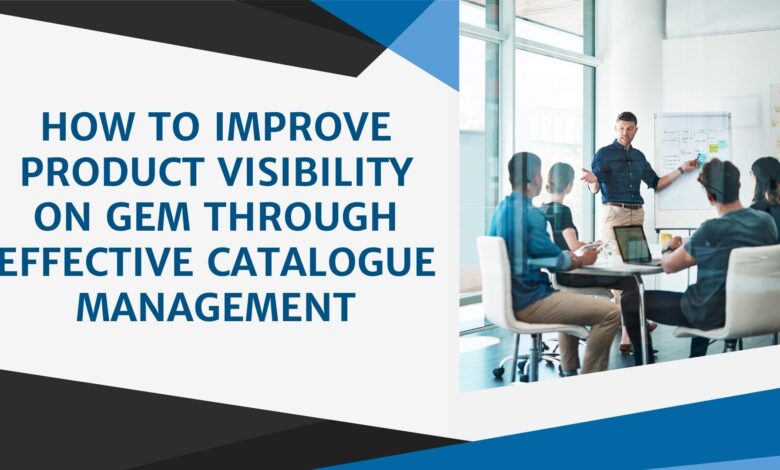How to Improve Product Visibility on GeM Through Effective Catalogue Management

GeM Catalogue Management refers to the process of organizing and maintaining your product listings on the GeM Portal platform to ensure they meet the requirements of government buyers and rank well in search results. This involves curating product descriptions, pricing, images, specifications, and other essential information that helps buyers easily find and understand your offerings. Effective catalogue management is critical to boosting product visibility and driving more sales on the platform.
Why Product Visibility on GeM is Crucial
In any online marketplace, visibility is key to driving sales. The same applies to GeM. Vendors with highly visible product listings are more likely to attract attention from government buyers, which can lead to more contracts and sales opportunities. Conversely, poorly managed catalogues with incomplete or inaccurate information can result in low visibility, missed opportunities, and a negative impact on your business’s reputation.
The GeM platform’s search algorithm plays a significant role in determining how your products rank in search results. To maximize visibility, vendors must ensure their product listings are optimized according to the platform’s standards and best practices. Here’s how to achieve that.
Key Strategies for Improving Product Visibility on GeM
1. Accurate and Detailed Product Descriptions
The most fundamental aspect of effective catalogue management is having accurate, detailed, and keyword-rich product descriptions. Government buyers often rely on product descriptions to make informed purchasing decisions. When writing descriptions, ensure that you:
- Provide a clear and concise overview of the product.
- Include all relevant specifications such as size, weight, color, material, and technical features.
- Highlight unique selling points (USPs) that set your product apart from competitors.
- Use industry-specific terminology and keywords that buyers are likely to search for. Incorporating these keywords will help your product rank higher in search results.
For example, if you’re selling office chairs, instead of just stating “ergonomic chair,” you could describe it as “Ergonomic office chair with lumbar support, adjustable height, and high-density foam cushioning, ideal for long hours of desk work.”
2. High-Quality Product Images
Images are the first thing that catches a buyer’s attention. Including high-quality, professional images of your products is a must. Here’s what you should consider:
- Use clear, high-resolution images that show the product from multiple angles.
- Include close-up shots of key features to provide a better understanding of the product’s design and build quality.
- Ensure that images accurately represent the product and are free of distractions (no logos, watermarks, or background clutter).
- Make sure to follow GeM’s image guidelines regarding size, format, and resolution for optimized performance.
A well-presented image can increase the trust and interest of buyers, making them more likely to engage with your product listing.
3. Competitive Pricing
Price is one of the most critical factors government buyers consider on GeM. Ensuring competitive pricing can enhance your product’s visibility by making it more attractive to buyers. Here’s how to manage pricing effectively:
- Conduct market research to understand the pricing of similar products listed on GeM.
- Avoid overpricing or underpricing. Overpricing can deter buyers, while underpricing might raise concerns about the product’s quality.
- Take advantage of GeM’s dynamic pricing feature, which allows you to adjust your prices based on market conditions and competition.
- Ensure that your pricing reflects any value-added features or warranties that come with the product.
By offering competitive pricing, you increase the likelihood of your product being featured in filtered searches where buyers set price ranges.
4. Use of Relevant Product Categories and Attributes
GeM allows vendors to classify their products into specific categories and subcategories. Accurate categorization ensures that your product appears in relevant search results. Misclassified products can lead to reduced visibility and frustration for buyers. Consider the following when categorizing your products:
- Select the most appropriate product category and subcategory to avoid confusion.
- Use attributes (like size, color, brand, etc.) to provide additional detail and narrow down search filters.
- Keep up with updates to the GeM product taxonomy, as new categories and attributes are regularly added.
Proper categorization helps buyers quickly find your products when they search within specific categories.
5. Consistent Stock Availability
Maintaining consistent stock availability is crucial for keeping your product visible and attractive to government buyers. Here’s how you can manage your inventory effectively:
- Regularly update your GeM catalogue with real-time stock levels to ensure that buyers can purchase the product without delay.
- Use GeM’s inventory management tools to receive alerts when stock levels are low, preventing stockouts that can reduce your visibility.
- Ensure fast replenishment processes to minimize downtime for out-of-stock items.
If a product is frequently out of stock, it may rank lower in search results, reducing its chances of being seen by buyers.
6. Positive Vendor Ratings and Reviews
Vendor ratings and reviews are essential trust signals for government buyers. Maintaining a good reputation on GeM can significantly improve your product’s visibility. Buyers are more likely to purchase from vendors with high ratings and positive reviews. To enhance your rating:
- Deliver orders on time and ensure product quality meets buyer expectations.
- Respond promptly to buyer inquiries and resolve any issues professionally.
- Encourage satisfied buyers to leave positive reviews after their purchase.
A strong vendor rating and good reviews will help your products rank higher in search results, as GeM’s algorithm favors reputable sellers.
7. Compliance with GeM’s Standards and Policies
GeM has specific compliance standards that all vendors must meet to ensure a fair and transparent procurement process. Non-compliance with these standards can lead to penalties, including removal from the platform or reduced visibility. Key compliance areas include:
- Ensuring that all products meet the required technical specifications and certifications.
- Adhering to GeM’s pricing guidelines and policies on product authenticity.
- Complying with regulations related to packaging, delivery, and return policies.
Vendors who consistently meet compliance standards are more likely to maintain high visibility on GeM.
8. Leveraging Analytics for Catalogue Optimization
GeM provides vendors with analytical tools that offer insights into product performance, including views, clicks, and sales data. Use these analytics to identify areas where your product listings can be improved. Consider the following:
- Track which products are performing well and which are underperforming.
- Analyze buyer behavior to understand what keywords, categories, or features are driving traffic.
- Use data insights to refine product descriptions, adjust pricing, and optimize images for better results.
By leveraging data, you can make informed decisions about how to optimize your catalogue for maximum visibility.
9. Regular Updates and Catalogue Maintenance
A static GeM catalogue can become outdated quickly, which can negatively impact your product visibility. Regular updates are essential to stay relevant and competitive. Here’s how you can maintain your catalogue effectively:
- Regularly review and update product descriptions, images, and specifications based on buyer feedback and industry changes.
- Add new products to your catalogue as your business expands its offerings.
- Remove outdated or discontinued products to avoid cluttering your catalogue.
Frequent updates signal to GeM’s algorithm that your product listings are active and well-maintained, helping to boost their visibility.
Conclusion
Improving product visibility on GeM through effective catalogue management requires a proactive and strategic approach. From optimizing product descriptions and images to maintaining competitive pricing and compliance, each aspect of your GeM catalogue Service plays a role in ensuring your products stand out to government buyers. By following these strategies, you can enhance your product’s search rankings, increase buyer engagement, and ultimately drive more sales on the platform.
Effective catalogue management is not a one-time effort but an ongoing process of optimization and improvement. As the GeM platform evolves and the competition grows, vendors who prioritize catalogue management will be best positioned to succeed in this dynamic marketplace.




